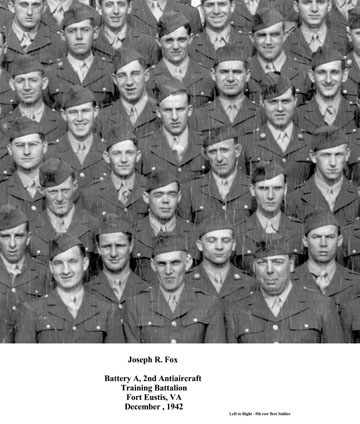Fourth Infantry Division in Europe
Joseph Fox served in the U.S. Army from 1942 to demobilization in early 1946. He graduated in December 1942 from the Fort Eustis, Virginia Anti-Aircraft School. He was assigned to the 377th Anti-Aircraft Battalion of the First Army’s 4th Infantry Division and served in that division throughout the war. The Fourth was called the "Ivy Division" because of the ivy leaves on its shoulder patch. The name was originally derived from a word play on the Roman numeral IV .... IV...y. His anti-aircraft unit would normally have been attached to the artillery unit of the division.
![]()

The "track" he was assigned to and talks about in the interview conducted November 15th 1997 was an armored half-track vehicle. This meant that it had truck wheels in the front and tractor wheels in the rear. It was an armored, highly mobile, 10 ton, twenty foot long vehicle that could achieve 45 mph and had a range of 200 miles. It was a tough fighting machine.
It normally had a 5-man crew – gunner, 2 loaders, vehicle driver, and a commander. This type of "track" was armed with Browning 50-caliber machine guns on a special mount and other weapons. The typical Maxson mount consisted of 4 machine guns firing in tandem, although some vehicles had 2 machine guns.
The machine guns could fire 400-500 rounds per minute up to their maximum range of 7,200 yards (4 miles). In addition to its anti-aircraft role, it was a very effective attack or defensive weapon against infantry and was often used in that capacity. The heavy 50 caliber bullets could punch through most light armor and destroy the target. While being in an armored half-track provided some protection against small arms fire, all armored vehicles were prime targets for destruction by opposing forces.
The 4th Infantry Division has a long and distinguished history from its formation in December 1917 to its current designation as the 4th Infantry Division (Mechanized) as part of the new Army’s Force XXI. It fought in both World Wars and in Vietnam.
The 8th Infantry Regiment of the 4th Division was the first Allied unit to lead the assault on Utah Beach in Normandy. More than 5,000 soldiers in the 4th Division lost their lives in the first 26 days of battle – one out of three.
After D-Day, it was involved in most of the critical battles in Europe – the breakout across France, the terribly costly Hurtgen Forest attack, Battle of the Bulge, initial crossing of the Rhine, and the invasion and conquest of Germany. It was considered one of the finest divisions in the Army and General Patton stated that he,
"…. knew of no American Division in France which exceed the magnificent record of the 4th Infantry Division."
Unfortunately, those who served in the "best" units or "magnificent" divisions were often selected for the most aggressive and costly attacks or defensive stands.
When it was at full strength, the 4th Infantry Division had about 14,000 basic infantry soldiers and 2,000 other attached soldiers assigned to artillery, antiaircraft and tanks.
In November 1944 the 4th Division participated in the deadly and inconclusive battle of the Hurtgen Forest (nicknamed the "Death Factory"). It suffered more than 5,000 battle casualties and 2,500 other casualties due to sickness and frostbite). It was finally pulled out of the line in the first week of December to be refitted, rested and brought up to strength in Luxembourg.
The rest was to be a brief one since the German Army was massing large numbers of tanks and overwhelming numbers of soldiers directly across the Sauer River from the 4th Division’s "quiet rest area". On December 16,1944, the Germans launched a massive attack against the sector held by the 4th Division. Joseph Fox and the 4th Division were soon to be in the crucible of the Battle of the Bulge.
In stopping the attack, the division suffered 1,718 casualties from December 16 to January 16. After surviving this battle, he and his division still faced five more months of bloody struggle to cross the Rhine and defeat the German Armies tenaciously defending the Fatherland.
In its 299 days of battle in the European Theater of Operations, it suffered 22,454 battle casualties and 13,091 non-battle casualties for a total of 35,545. The causality rate was 252 %. This was the highest casualty ratio of all 44 U.S. Army Divisions that had fought in Europe.
Of those soldiers of the 4th Division who waded ashore at Normandy, few were left to celebrate the surrender of Germany.
Joseph Fox was one of the lucky ones.
J. Gary Fox
December 1997
Two letters from Joseph in Occupied Germany 1945 - May 16, 1945 and May 23, 1945